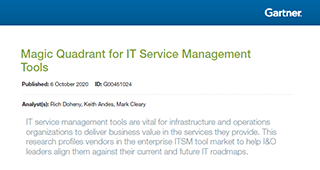Embrace what’s working. Get rid of what’s not.
Specialized software now exists to help businesses with individual lines of business or functions. There are business solutions to aid IT in managing its workflows, software to help human resources track employment records, and there are dozens of customer relationship management (CRM) applications to assist sales and marketing in tracking sales leads and vendor contacts.
These tools often have overlapping information about the same customers and may even duplicate processes. But because they’re dispersed across the organization, each department is on its own to enter and manage its individual database. What’s worse, the hyperfocus of these applications can lead each team to fixate only on its small corner of the organization, rather than the needs of the business as a whole.
It’s no surprise that many of these solutions aren’t really solving anything at all. Instead they’re tools with outdated processes that are costing organizations time and money, while frustrating the people who use them day in and day out.

The Problem with Legacy Solutions
Oftentimes, the solutions and tools in place are legacy applications implemented years ago. They were implemented without much thought of future scalability, or whether the tools would even advance the organization’s goals. These so-called solutions were implemented as quick fixes, and in the long run they end up costing the company time, money, and a precious edge against the competition.
Your team simply isn’t as productive as it could be. According to a Forrester study, nearly 90 percent of global business users say they lose 18 hours a month to IT inefficiencies. Fourteen percent say they lose a whopping 90 hours per month.
This isn’t acceptable.
Looking Internally for Solutions
Replacing legacy solutions is expensive, which is why it’s important to take stock of existing platforms and services. Some of the tools in our current arsenals are simply underutilized. Or they’ve been overlooked when it comes to system updates because the process takes too long and causes too much internal hassle.
By updating and leveraging an existing HR or CRM solution or investing in a more diverse, multi-purpose solution that is modern, agile, and flexible, organizations can get more done while minimizing expenses and reducing implementation risks. Think about how a solution can be extended to other departments and its ability to meet future business needs.
Minimizing Risk, Maximizing Value
As you take into consideration what’s working and what can be updated, it’s important to keep the company and its employees’ security in mind. For example, if IT and HR share a database of employees’ start and stop dates, it can speed up the onboarding process and reduce risks during termination. But it also opens sensitive employee data up to teams that at best don’t need the information. And at worse, use it for the wrong purposes.
The key is finding tools that can segregate information based on security and privacy protocols, while not being so stringent that their permissions process makes them unwieldy and ineffective. It’s a delicate balance, but plenty of organizations around the world are finding ways to replace what’s broken and update what’s working, all the while minimizing risk and setting the company up for even more success in the future.
Remember: establishing and implementing IT solutions is an iterative process. There will always be new needs, unforeseen challenges and new business requirements to keep IT teams on their toes.







